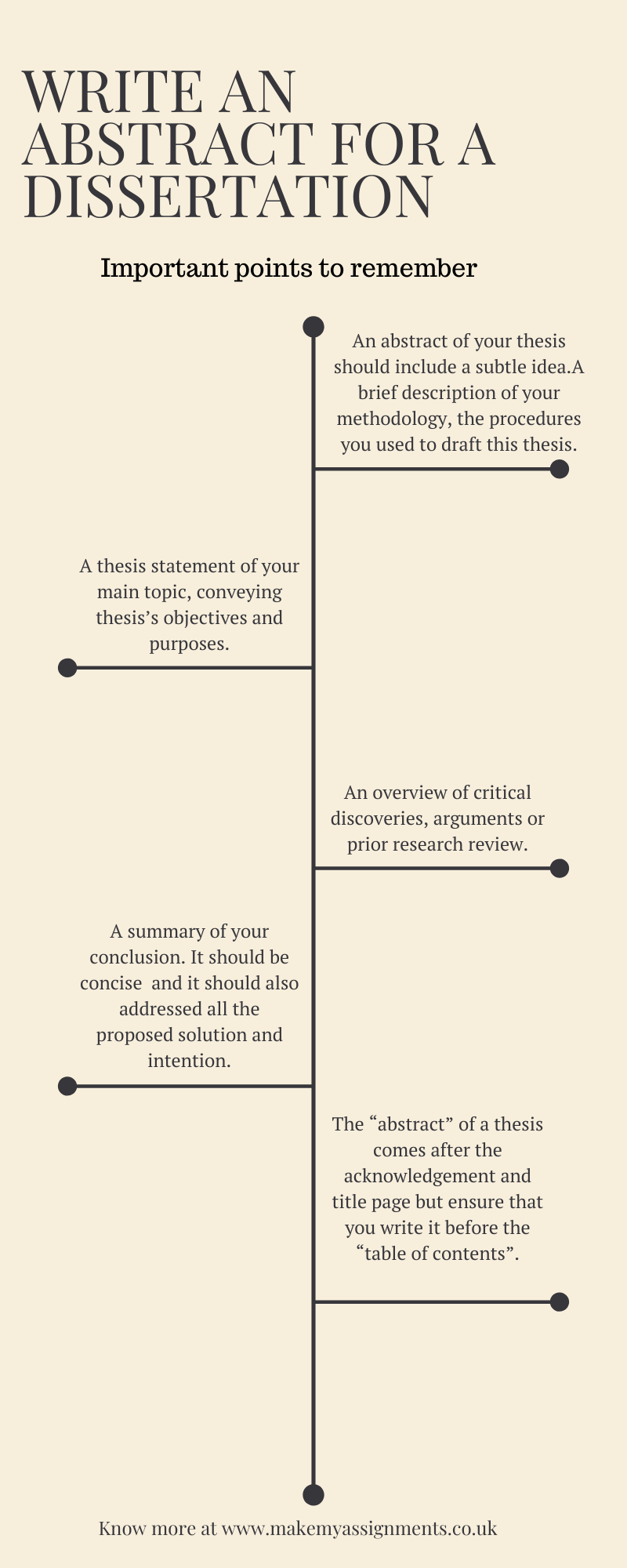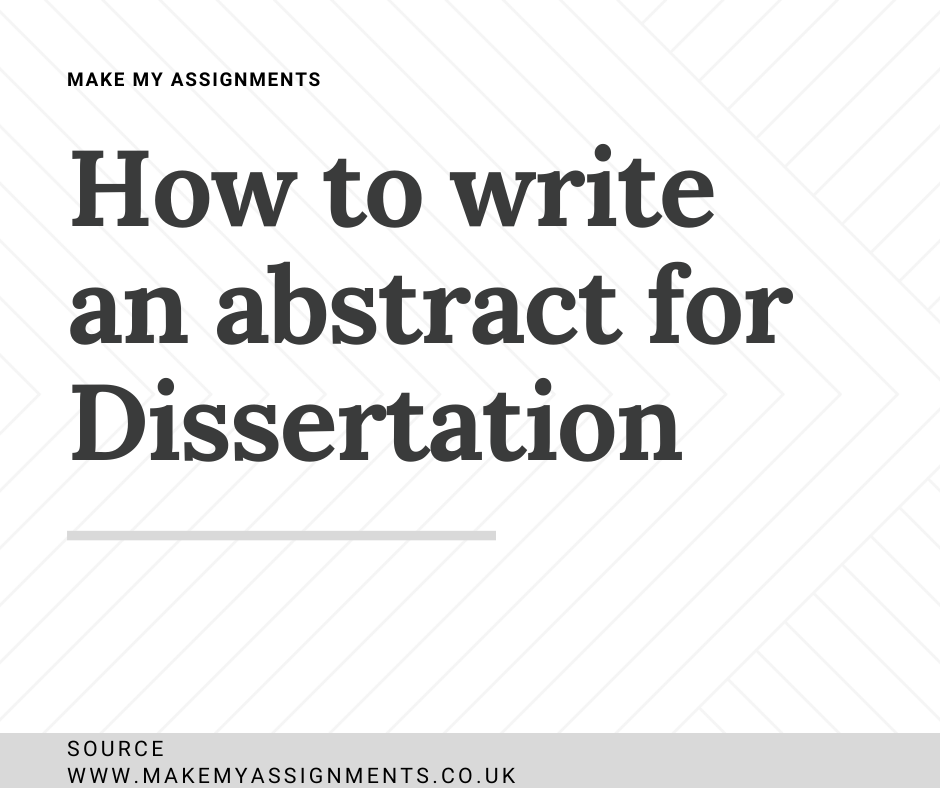Table of Contents
Your thesis and dissertations should always include an abstract. The main aim of writing an abstract at the beginning of your thesis is to summarise the content of your dissertation in a formulaic and systematic manner.
The abstract of a thesis serves as a short-hand of the full piece of the thesis. It allows the audience to quickly determine what your paper is about and decide if it’s worth giving a read. Before getting into further details on how to write an abstract, it is always recommended to take some assistance from online assignment helpers to get the utmost practical knowledge. For people who do not have enough time to go through the whole text, the abstract tries to offer a condensed overview of all of your important points.
- An abstract of your thesis should include a subtle idea.
- A brief description of your methodology, the procedures you used to draft this thesis.
- A thesis statement of your main topic, conveying thesis’s objectives and purposes.
- An overview of critical discoveries, arguments or prior research review.
- A summary of your conclusion.
- Although it may appear at the very starting of your document, it should be the last thing you should write in your document. The “abstract” of a thesis comes after the acknowledgement and title page but ensure that you write it before the “table of contents”.
Writing an abstract
Here is one statement that can certainly help you in writing an abstract. Writing an abstract includes boiling down all the essence of the whole document into a short piece of writing around 150-200 words, that convey the core information about the dissertation. One way of writing an effective abstract is to go through your project/dissertation and determine the following traits.
- What are the highlights of your conclusion and main objectives? (Check your discussions, introduction and perhaps conclusion )
- Find out the bracket information in the methodology section which contains key information.
- It highlights the results from the result section or discussion.
- Compile both the key information and highlighted main points into a single paragraph.
- Delete phrases and extra words.
- Condense the bracketed information into phrases and keywords which recognise the methodology. ( You are not required to explain the methodology into the abstract )
- Delete phrases and extra words.
- Delete all sort of background information.
- Revise the abstract so that you can be ensured that it conveys the necessary information.
- We advise rephrasing the first sentence of your abstract so that it can start from determining what is certain or new about your thesis/ dissertation rather than emphasizing on a niche topic. One way of doing this is to always begin the first sentence with phrases such as “this thesis” or “this study” or “this dissertation”.
Main features of an Abstract
Thoroughness
The abstract should always represent the core of the entire dissertation, not just some certain vital points of it. Objectives, methodology, analysis, literature review and conclusions: all of them should be summarised in the abstract. Make sure the abstracts are used to give an idea about your thesis and what the readers should expect from the thesis.
Terminology
Both general and specifics of your subject areas should be included in the key terms of your abstract. This will provide a contextual means for browsing research academics to recognise the aim and character of your thesis as a whole.

Authority
You should set the tone of your thesis by creating an authoritative academic tone early in your abstract. The reader should feel your comfort with the topic of the thesis at the beginning of your thesis. This will set up an early impression that your work on this thesis is credible and professional.
Salesmanship
Usually, a crass alternative to think about the aim of your abstract, but useful nonetheless. The abstract of your thesis will decide whether or not your thesis’s most likely to be useful to them for their study. Indicate the importance of your research and make sure it emphasizes the rigorous methods.
Balance
In the same way, a dissertation as a whole should always maintain the equal share of space between several chapters, so to the abstract must reflect the balance. Look at the marketing criteria to identify which portion weighs certain marks and organise the abstract of your thesis appropriately.
Clarity of expression
As earlier mentioned, the abstract needs a concise writing technique to keep the total word count low. In summarising a large volume of materials, be careful about lack of clarity and danger of obscurity. Therefore, ensure that the abstract is not completely incomprehensible to an intelligent layman.
Go through the published material
As with most of the aspects of writing a thesis, useful templets and modals can be found in several research paper archives and resources. Make sure you go through all published thesis and familiarise yourself with how precise abstracts are written. You can take help from numerous study resources and encyclopedias such as Scribd, Google Scholar and Britannica.
Avoid verbosity
Make sure you don’t exceed the word count. So, retain your focus and avoid all unnecessarily superfluous and florid language. Keep it short, simple and clear within your university guidelines.
The length of an abstract
Normally, an abstract should not exceed one text or page. But, it is critical to verify all departmental specifications to ensure about thesis requirements and abstract conforms. Exceeding the given limit in length is a serious concern. That indicates a lack of understanding as to the main idea behind writing an abstract.
However, there are no set guidelines to write an abstract, as not every abstract contain precisely the exact same elements. ( For instance, an art dissertation builds the thesis argument through different chapters from a marketing evaluation done for business communication).
You can use the technique of reverse outline. It states to list of key pieces of information. Plus, 1-2 sentence which summarises the central argument of that particular section. This will provide you with a framework for your abstract’s structure. Finally, the last step in reverse outlining is to revise all these sentences. And, find relevance between all contexts and show how the dissertation argument develops.
Additional Notes
Besides, if you are struggling with creating a precise abstract for your research paper. You can refer to some of the useful tips for writing an assignment. There are writers that can go through tri-step modal to analyse, review and edit your research paper. Also, they will make sure it is in accordance with your university guidelines.
It is also utterly recommended to check your document with a plagiarism checker. It will ensure that there are no grammar or plagiarism issues in your paper. Moreover, You can avail their services at a minimal cost. You can ensure no-marks deduction in principle key areas of writing a thesis. The areas such as Abstracts, references, table of contents, methodology and conclusion.
